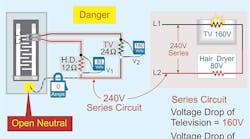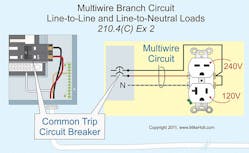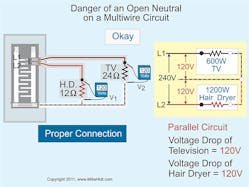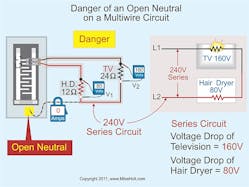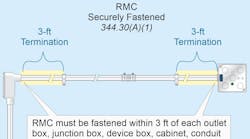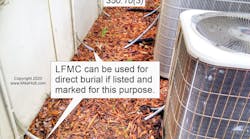All questions and answers are based on the 2011 NEC.
Q. What are the requirements when terminating equipment grounding conductors, grounding electrode conductors, and bonding jumpers?
A. Equipment grounding conductors, grounding electrode conductors, and bonding jumpers must terminate in one of the following methods [250.8(A)]:
1) Listed pressure connectors
2) Terminal bars
3) Pressure connectors listed for direct burial or concrete encasement [250.70]
4) Exothermic welding
5) Machine screws that engage at least two threads or are secured with a nut
6) Self-tapping machine screws that engage at least two threads
7) Connections that are part of a listed assembly
8) Other listed means.
Connection devices or fittings that depend solely on solder aren’t allowed [250.8(B)].
Q. What are the minimum cover requirements for PVC and UF cable in dwelling occupancies?
A. PVC and UF cable in dwelling occupancies that are rated 120V or less with GFCI protection and maximum overcurrent protection of 20A can be installed with 12 in. of cover minimum.
Q. What are the Code rules for multiwire branch circuits?
A. A multiwire branch circuit is one that consists of two or more ungrounded circuit conductors with a common neutral conductor. There must be a difference of potential (voltage) between the ungrounded conductors and an equal difference of potential (voltage) from each ungrounded conductor to the common neutral conductor. A multiwire branch circuit can be considered a single circuit or a multiple circuit [210.4(A)].
To prevent inductive heating and to reduce conductor impedance for fault currents, all conductors of a multiwire branch circuit must originate from the same panelboard. For more information on the inductive heating of metal parts, see 300.3(B), 300.5(I), and 300.20.
Informational Note [to 210.4(A)]: Unwanted and potentially hazardous harmonic neutral currents can cause additional heating of the neutral conductor of a 4-wire, 3-phase, 120/208V or 277/480V wye-connected system, which supplies nonlinear loads. To prevent fire or equipment damage from excessive harmonic neutral currents, the designer should consider:
1) Increasing the size of the neutral conductor, or
2) Installing a separate neutral for each phase.
Each multiwire branch circuit must have a means to simultaneously disconnect all ungrounded conductors at the point where the branch circuit originates [210.4(B)]. Individual single-pole circuit breakers with handle ties identified for the purpose can be used for this application [240.15(B)(1)].
Caution: This rule is intended to prevent people from working on energized circuits they thought were disconnected.
Multiwire branch circuits must supply only line-to-neutral loads [210.4(C)].
Exception No. 1: A multiwire branch circuit is permitted to supply an individual piece of line-to-line utilization equipment, such as a range or dryer.
Exception No. 2: A multiwire branch circuit is permitted to supply both line-to-line and line-to-neutral loads if the circuit is protected by a device such as a multipole circuit breaker with a common internal trip that opens all ungrounded conductors of the multiwire branch circuit simultaneously under a fault condition (see Fig. 1).
Informational Note: See 300.13(B) for the requirements relating to the continuity of the neutral conductor on multiwire branch circuits.
Caution: If the continuity of the neutral conductor of a multiwire circuit is interrupted (opened), the resultant over- or undervoltage can cause a fire and/or destruction of electrical equipment (Fig. 2 and Fig. 3).
The ungrounded and neutral conductors of a multiwire branch circuit must be grouped together by cable ties or similar means at the point of origination [210.4(D)].
Exception: Grouping isn’t required where the circuit conductors are contained in a single raceway or cable unique to that circuit that makes the grouping obvious.
Grouping all associated conductors of a multiwire branch circuit together by cable ties or other means within the point of origination makes it easier to visually identify the conductors of the multiwire branch circuit. The grouping will assist in making sure that the correct neutral is used at junction points and in connecting multiwire branch circuit conductors to circuit breakers correctly, particularly where twin breakers are used. If proper diligence isn’t exercised when making these connections, two circuit conductors can be connected accidentally to the same phase.
Caution: If the ungrounded conductors of a multiwire circuit aren’t terminated to different phases or lines, the currents on the neutral conductor won’t cancel but will add, which can cause an overload on the neutral conductor.
Q. How do I size the conductors and protection device for a feeder to several motors?
A. Circuit conductors that supply several motors must not be sized smaller than the sum of the following [430.24]:
1) 125% of the full-load current of the highest rated motor.
2) The full-load current ratings of other motors.
Q. How many 10 AWG conductors can I install in a trade size 1 PVC raceway?
A. Raceways must be large enough to permit the installation and removal of conductors without damaging the conductors’ insulation, and the number of conductors must not exceed that permitted by the percentage fill specified in Table 1, Chapter 9 [352.22]. When all conductors in a raceway are the same size and insulation, the number of conductors permitted can be found in Annex C for the raceway type.
If you’re using Schedule 40 PVC, then you can fit 15 conductors [Annex C, Table C10] in it. Although Schedule 80 PVC conduit has the same outside diameter as Schedule 40 PVC conduit, the wall thickness of Schedule 80 PVC conduit is greater, which results in a reduced interior area for conductor fill. Therefore, you can only fit 13 conductors [Annex C, Table C9] in this type of conduit.
